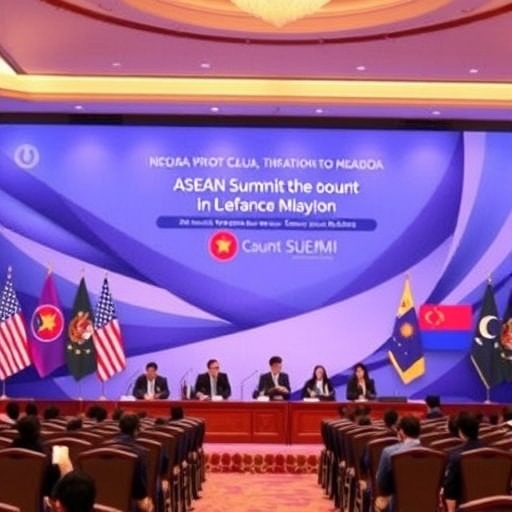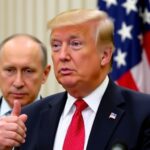ASEAN Summit Opens in Kuala Lumpur: Leaders Confront Security Risks, US Tariffs, and Global Turbulence in Trade
In a city pulsing with diplomatic energy, the ASEAN Summit kicked off in Kuala Lumpur today, drawing leaders from across Southeast Asia to address a perfect storm of regional security threats, volatile trade dynamics, and the ripple effects of US tariffs amid escalating global turbulence. Malaysian Prime Minister Anwar Ibrahim set the tone in his opening remarks, declaring, “We stand at a crossroads where unity is not just desirable, but essential to safeguard our prosperity and peace.” With tensions in the South China Sea simmering and economic pressures mounting from protectionist policies abroad, the summit promises to be a pivotal moment for the 10-nation bloc, representing over 670 million people and a combined GDP exceeding $3.6 trillion.
The gathering, hosted by Malaysia under the theme “Inclusivity and Sustainability,” comes at a time when ASEAN nations are grappling with multifaceted challenges. From cyber threats and territorial disputes to supply-chain disruptions exacerbated by the ongoing Russia-Ukraine conflict and potential escalations in US-China relations, leaders are under pressure to forge actionable strategies. Early sessions focused on bolstering collective security measures while mitigating the economic fallout from US tariffs, which analysts estimate could shave up to 0.5% off regional growth in the coming year if not addressed.
Attendees, including heads of state from Indonesia, Thailand, Vietnam, and the Philippines, arrived amid heightened security protocols, underscoring the summit’s emphasis on stability. The agenda, packed with over 20 bilateral and multilateral meetings, highlights ASEAN’s role as a linchpin in the Indo-Pacific, where trade volumes topped $3.5 trillion last year alone. As global turbulence—from inflation spikes to geopolitical flashpoints—looms large, the bloc’s resilience will be tested like never before.
Fortifying Regional Security Amid South China Sea Tensions
Security dominated the opening plenary, with ASEAN leaders zeroing in on maritime disputes in the South China Sea, a waterway through which $3.4 trillion in global trade flows annually. Philippine President Ferdinand Marcos Jr. voiced strong concerns, stating, “The freedom of navigation we all cherish is under threat, and ASEAN must speak with one voice to uphold international law.” Recent incidents, including Chinese coast guard vessels clashing with Philippine fishing boats near the Spratly Islands, have heightened alarms, prompting calls for enhanced joint patrols and intelligence-sharing among member states.
Indonesia’s Foreign Minister Retno Marsudi emphasized the need for a binding Code of Conduct (COC) with China, a negotiation that has dragged on for over two decades. Statistics from the Asia Maritime Transparency Initiative reveal over 200 Chinese incursions into disputed waters in the past year, fueling fears of escalation. To counter this, summit discussions proposed expanding the ASEAN Regional Forum (ARF) to include more robust cyber defense protocols, given the surge in state-sponsored hacks targeting Southeast Asian infrastructure—up 35% since 2022, according to cybersecurity firm CrowdStrike.
Beyond the seas, terrestrial threats like Myanmar’s ongoing civil unrest pose spillover risks. Leaders reiterated support for a Five-Point Consensus on the crisis, though progress remains elusive. Thai Prime Minister Srettha Thavisin highlighted the humanitarian angle, noting that over 2.6 million people have been displaced, straining border resources. In a bid to strengthen ties, ASEAN is exploring trilateral dialogues with dialogue partners like Japan and Australia to bolster defense capabilities without alienating key players.
The security talks also touched on non-traditional threats, such as climate-induced disasters. With the region facing 10 of the world’s 20 most vulnerable countries to extreme weather, per the Global Climate Risk Index, initiatives like the ASEAN Comprehensive Recovery Framework aim to integrate disaster response into broader security strategies. Experts predict that without unified action, these vulnerabilities could amplify global turbulence, inviting external interference.
US Tariffs Spark Urgent Trade Strategy Overhaul
Trade took center stage as ASEAN economies brace for the blunt force of US tariffs, particularly those targeting electric vehicles, semiconductors, and steel—sectors where the region holds a $200 billion surplus with America. Vietnamese Prime Minister Pham Minh Chinh warned, “Protectionism in one corner of the globe disrupts supply chains everywhere; we must diversify to endure.” The Biden administration’s recent hike on Chinese imports has indirectly hit ASEAN, with Vietnam and Malaysia seeing a 15% dip in exports to the US in Q3 2023, data from the World Trade Organization shows.
At the heart of the discussions is the Regional Comprehensive Economic Partnership (RCEP), the world’s largest trade bloc, which ASEAN champions to offset US tariffs. Covering 30% of global GDP, RCEP has already boosted intra-regional trade by 7.5% since its 2022 inception. Leaders are pushing for accelerated implementation, including tariff reductions on 90% of goods, to shield members from external shocks. Singapore’s Trade Minister Gan Kim Yong outlined plans for digital trade corridors, leveraging the bloc’s 400 million internet users to streamline e-commerce amid physical supply-chain woes.
Yet, challenges persist. The US tariffs, potentially expanding under a new administration, could cost ASEAN $50 billion in lost revenues by 2025, per a report from the ASEAN Secretariat. Indonesia, the bloc’s largest economy, is particularly exposed, with its nickel and palm oil exports facing scrutiny. To mitigate, summit delegates are negotiating free trade agreements with the EU and India, aiming to tap into markets worth $1.5 trillion. A key proposal involves harmonizing standards for green technologies, positioning ASEAN as a hub for sustainable manufacturing and countering tariff-induced fragmentation.
Private sector voices echoed these sentiments. Apple CEO Tim Cook, addressing a related business forum, stressed, “ASEAN’s agility in trade is unmatched, but tariffs demand innovation in diversification.” With foreign direct investment (FDI) inflows reaching $222 billion in 2023—up 10% year-over-year—opportunities abound, but only if leaders navigate the global turbulence wisely.
Supply-Chain Stability Emerges as Resilience Pillar
As global turbulence disrupts logistics from the Red Sea to the Taiwan Strait, ASEAN’s focus on supply-chain stability underscores its drive for economic fortitude. Malaysian officials reported that the summit would unveil a new ASEAN Supply Chain Resilience Initiative, targeting vulnerabilities exposed by the COVID-19 pandemic and recent geopolitical flare-ups. “We’ve learned that over-reliance on single sources is a recipe for crisis,” said Anwar Ibrahim, pointing to the 2021 Suez Canal blockage that delayed $9 billion in daily trade.
Key to this is diversifying manufacturing bases. Vietnam has emerged as a winner, with FDI in electronics surging 25% to $20 billion, as firms like Samsung shift from China. However, Thailand and Cambodia face bottlenecks, with port congestions in Laem Chabang adding 20% to shipping costs. The initiative proposes investing $100 billion in infrastructure over the next five years, including high-speed rail links and digital tracking systems to enhance transparency.
Statistics paint a stark picture: ASEAN’s integration into global value chains accounts for 60% of its exports, but disruptions have inflated costs by 12-15% since 2022, according to the Asian Development Bank (ADB). To build resilience, leaders are advocating for public-private partnerships, with examples like Indonesia’s $15 billion just energy transition plan drawing interest from green investors. Climate resilience is woven in, addressing how typhoons and floods—costing the region $30 billion annually—threaten supply lines.
Broader context includes energy security. With 40% of ASEAN’s oil imports from the Middle East, volatility from conflicts has spiked prices 20%. Summit talks explore renewable alternatives, aiming for 23% clean energy by 2025, per the ASEAN Plan of Action for Energy Cooperation. This holistic approach not only buffers against US tariffs but positions the bloc as a stable partner in turbulent times.
Global Turbulence Prompts Calls for Unified ASEAN Voice
The specter of global turbulence—encompassing US elections, Middle East tensions, and economic slowdowns—has ASEAN leaders urging a more assertive stance. Cambodian Prime Minister Hun Manet captured the mood: “In an era of uncertainty, ASEAN’s centrality is our greatest asset.” The summit highlighted how fragmented responses could erode the bloc’s influence, especially as major powers vie for sway in the region.
Analysts from the Institute of Southeast Asian Studies note that political turbulence, including potential US policy shifts post-2024 elections, could impose new tariffs on 25% of ASEAN goods. To counter, Indonesia proposed enhancing the ASEAN Outlook on the Indo-Pacific (AOIP), a framework to promote inclusive cooperation. This includes dialogues with the US, China, and the EU to de-escalate trade frictions.
Human capital is another front. With youth unemployment at 13% amid automation, education and skills programs are vital. The summit endorsed expanding the ASEAN Work Plan on Education, targeting digital literacy for 50 million workers by 2030. Health security, post-pandemic, features prominently, with commitments to a $5 billion vaccine fund.
Environmental turbulence rounds out concerns. Deforestation rates, highest globally at 1.2 million hectares yearly, threaten biodiversity and livelihoods. Leaders pledged to accelerate the ASEAN Peatland Management Strategy, aiming to restore 1 million hectares by 2025, aligning with global sustainability goals.
Outlook: ASEAN’s Roadmap to Navigate Uncertain Horizons
As the Kuala Lumpur summit progresses into closed-door negotiations, the path forward hinges on tangible commitments. Leaders are set to adopt a declaration on enhanced security cooperation, including annual joint exercises, and a trade resilience pact to cap tariff impacts at under 5% through RCEP expansions. Looking ahead, ASEAN’s Economic Community blueprint envisions $4 trillion in GDP by 2025, contingent on weathering global turbulence.
Next steps include follow-up ministerial meetings in 2024, focusing on implementation. With US tariffs looming and security hotspots flaring, the bloc’s ability to act cohesively could redefine Southeast Asia’s role in global affairs. Investors and allies alike will watch closely, as ASEAN’s resilience today shapes tomorrow’s stability. In the words of Anwar Ibrahim, “Together, we turn challenges into opportunities for a brighter, more secure future.”
The summit concludes Friday, but its echoes will resonate through boardrooms and battlefields alike, underscoring ASEAN’s enduring relevance in a turbulent world.








